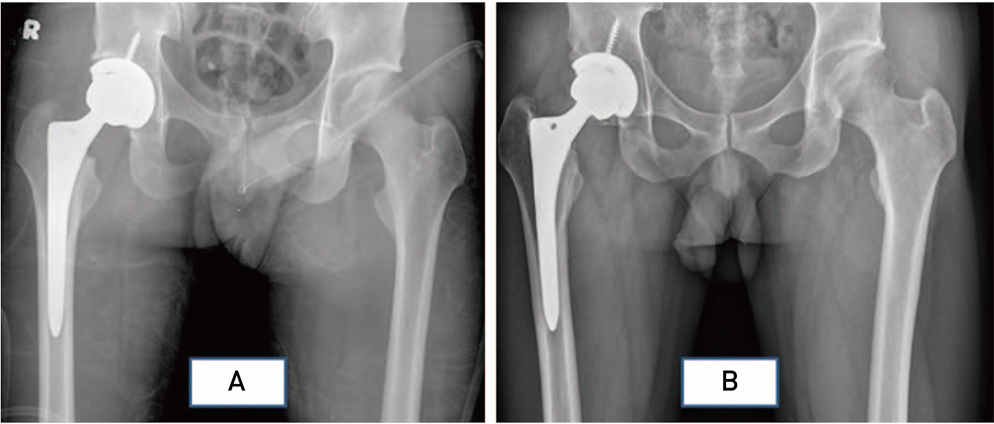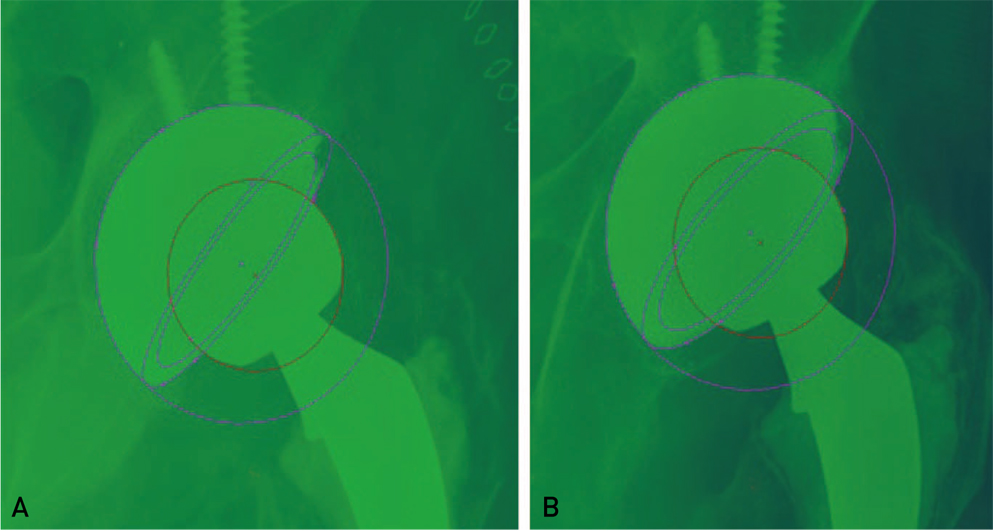Hip Pelvis.
2016 Jun;28(2):76-81. 10.5371/hp.2016.28.2.76.
Results of Primary Total Hip Arthroplasty Using 36 mm Femoral Heads on 1st Generation Highly Cross Linked Polyethylene in Patients 50 Years and Less with Minimum Five Year Follow-up
- Affiliations
-
- 1Department of Orthopaedic Surgery, Catholic University of Daegu College of Medicine, Daegu, Korea. cmr0426@cu.ac.kr
- KMID: 2328342
- DOI: http://doi.org/10.5371/hp.2016.28.2.76
Abstract
- PURPOSE
We evaluated the clinical and radiographic midterm results of primary total hip arthroplasty (THA) using a 36 mm diameter femoral head on 1st generation highly cross-linked polyethylene (HXLPE) in patients 50 years and less with minimum five year follow-up.
MATERIALS AND METHODS
We retrospectively reviewed 31 patients (41 hips) aged 50 years and less underwent primary THA with a 36 mm diameter femoral head on HXLPE between 2004 and 2010. Clinical follow-ups included specific measurements like modified Harris hip scores (HHS) and Merle d'Aubigne and Postel score. For radiologic evaluations, together with position of acetabular cup at six weeks later of postoperation, we separately calculated the penentrations of femoral head into polyethylene liners during postoperation and one year later check-ups, and during one year later check-ups and final check-ups.
RESULTS
There were no major complications except for one case of dislocation. Average modified HHS at final follow-up was 88 (81-98), and Merle d'Aubigne and Postel scores were more than 15. Mean acetabular cup inclination and anteversion were 45.81°(36.33°-54.91°) and 13.26°(6.72°-27.71°), respectively. Average femoral head penetration of steady-state wear rate determined using radiographs taken at one-year postoperatively and at latest follow-up was 0.042±0.001 mm/year.
CONCLUSION
Based on minimum 5 years clinical results, we think 36 mm metal head coupling with HXLPE as the good alternate articulation surface when planning THA for patients aged 50 years and less.
MeSH Terms
Figure
Cited by 1 articles
-
Results of Total Hip Arthroplasty with 36-mm Metallic Femoral Heads on 1st Generation Highly Cross Linked Polyethylene as a Bearing Surface in Less than Forty Year-old Patients: Minimum Ten-year Results
Won Kee Choi, Jae Jung Kim, Myung-Rae Cho
Hip Pelvis. 2017;29(4):223-227. doi: 10.5371/hp.2017.29.4.223.
Reference
-
1. Schmalzried TP, Jasty M, Harris WH. Periprosthetic bone loss in total hip arthroplasty. Polyethylene wear debris and the concept of the effective joint space. J Bone Joint Surg Am. 1992; 74:849–863.
Article2. Babovic N, Trousdale RT. Total hip arthroplasty using highly cross-linked polyethylene in patients younger than 50 years with minimum 10-year follow-up. J Arthroplasty. 2013; 28:815–817.
Article3. Delasotta LA, Rangavajjula AV, Porat MD, Frank ML, Orozco FR, Ong AC. What are young patients doing after hip reconstruction? J Arthroplasty. 2012; 27:1518–1525.e2.
Article4. Heisel C, Silva M, Schmalzried TP. Bearing surface options for total hip replacement in young patients. Instr Course Lect. 2004; 53:49–65.
Article5. Yoo JJ, Kim YM, Yoon KS, Koo KH, Song WS, Kim HJ. Alumina-on-alumina total hip arthroplasty. A five-year minimum follow-up study. J Bone Joint Surg Am. 2005; 87:530–535.6. Bistolfi A, Crova M, Rosso F, Titolo P, Ventura S, Massazza G. Dislocation rate after hip arthroplasty within the first postoperative year: 36 mm versus 28 mm femoral heads. Hip Int. 2011; 21:559–564.
Article7. Geller JA, Malchau H, Bragdon C, Greene M, Harris WH, Freiberg AA. Large diameter femoral heads on highly cross-linked polyethylene: minimum 3-year results. Clin Orthop Relat Res. 2006; 447:53–59.8. Hannouche D, Devriese F, Delambre J, et al. Ceramic-on-ceramic THA implants in patients younger than 20 years. Clin Orthop Relat Res. 2016; 474:520–527.
Article9. Kim YH, Choi Y, Kim JS. Cementless total hip arthroplasty with ceramic-on-ceramic bearing in patients younger than 45 years with femoral-head osteonecrosis. Int Orthop. 2010; 34:1123–1127.
Article10. Sentuerk U, von Roth P, Perka C. Ceramic on ceramic arthroplasty of the hip: new materials confirm appropriate use in young patients. Bone Joint J. 2016; 98-B:1 Suppl A. 14–17.11. Engh CA, Bobyn JD, Glassman AH. Porous-coated hip replacement. The factors governing bone ingrowth, stress shielding, and clinical results. J Bone Joint Surg Br. 1987; 69:45–55.
Article12. Barrack RL, Mulroy RD Jr, Harris WH. Improved cementing techniques and femoral component loosening in young patients with hip arthroplasty. A 12-year radiographic review. J Bone Joint Surg Br. 1992; 74:385–389.
Article13. Engh CA, Griffin WL, Marx CL. Cementless acetabular components. J Bone Joint Surg Br. 1990; 72:53–59.
Article14. Kennedy JG, Rogers WB, Soffe KE, Sullivan RJ, Griffen DG, Sheehan LJ. Effect of acetabular component orientation on recurrent dislocation, pelvic osteolysis, polyethylene wear, and component migration. J Arthroplasty. 1998; 13:530–534.
Article15. Widmer KH. A simplified method to determine acetabular cup anteversion from plain radiographs. J Arthroplasty. 2004; 19:387–390.
Article16. Penmetsa JR, Laz PJ, Petrella AJ, Rullkoetter PJ. Influence of polyethylene creep behavior on wear in total hip arthroplasty. J Orthop Res. 2006; 24:422–427.
Article17. Willmann G. Ceramic femoral head retrieval data. Clin Orthop Relat Res. 2000; (379):22–28.
Article18. Capello WN, D'Antonio JA, Feinberg JR, Manley MT, Naughton M. Ceramic-on-ceramic total hip arthroplasty: update. J Arthroplasty. 2008; 23:7 Suppl. 39–43.
Article19. Jarrett CA, Ranawat AS, Bruzzone M, Blum YC, Rodriguez JA, Ranawat CS. The squeaking hip: a phenomenon of ceramic-on-ceramic total hip arthroplasty. J Bone Joint Surg Am. 2009; 91:1344–1349.
Article20. Nam D, Barrack T, Johnson SR, Nunley RM, Barrack RL. Hard-on-hard bearings are associated with increased noise generation in young patients undergoing hip arthroplasty. Clin Orthop Relat Res. 2016; 02. 24.
Article21. Lee JH, Lee BW, Lee BJ, Kim SY. Midterm results of primary total hip arthroplasty using highly cross-linked polyethylene: minimum 7-year follow-up study. J Arthroplasty. 2011; 26:1014–1019.
Article22. Dumbleton JH, Manley MT, Edidin AA. A literature review of the association between wear rate and osteolysis in total hip arthroplasty. J Arthroplasty. 2002; 17:649–661.
Article23. Pruitt LA. Deformation, yielding, fracture and fatigue behavior of conventional and highly cross-linked ultra high molecular weight polyethylene. Biomaterials. 2005; 26:905–915.
Article24. Tower SS, Currier JH, Currier BH, Lyford KA, Van Citters DW, Mayor MB. Rim cracking of the cross-linked longevity polyethylene acetabular liner after total hip arthroplasty. J Bone Joint Surg Am. 2007; 89:2212–2217.
Article25. Johnson AJ, Loving L, Herrera L, Delanois RE, Wang A, Mont MA. Short-term wear evaluation of thin acetabular liners on 36-mm femoral heads. Clin Orthop Relat Res. 2014; 472:624–629.
Article26. Mont MA, Maar DC, Krackow KA, Jacobs MA, Jones LC, Hungerford DS. Total hip replacement without cement for non-inflammatory osteoarthrosis in patients who are less than forty-five years old. J Bone Joint Surg Am. 1993; 75:740–751.
Article27. Stilling M, Larsen K, Andersen NT, Søballe K, Kold S, Rahbek O. The final follow-up plain radiograph is sufficient for clinical evaluation of polyethylene wear in total hip arthroplasty. A study of validity and reliability. Acta Orthop. 2010; 81:570–578.
Article
- Full Text Links
- Actions
-
Cited
- CITED
-
- Close
- Share
- Similar articles
-
- Results of Total Hip Arthroplasty with 36-mm Metallic Femoral Heads on 1st Generation Highly Cross Linked Polyethylene as a Bearing Surface in Less than Forty Year-old Patients: Minimum Ten-year Results
- Results of Primary Total Hip Arthroplasty with 36-mm Femoral Heads on Highly Cross-linked Polyethylene-Minimum Seven-years Follow-up
- A Liner Breakage in Total Hip Arthroplasty after Using 1st Generation Highly Cross Linked Polyethylene Mated against 36-mm Metal Head: A Case Report
- The Wear Rate and Survivorship in Total Hip Arthroplasty Using a Third-generation Ceramic Head on a Conventional Polyethylene Liner: A Minimum of 15-year Follow-up
- Total Hip Arthroplasty Using Metal Head on a Highly Cross-linked Polyethylene Liner



